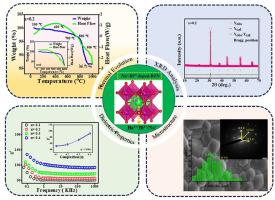Synergistic A-site co-doping of (Na1/2Bi1/2)xBa1−xZn1/3Nb2/3O3 perovskites: doping mechanisms, microstructure and impedance studies
IF 6.8
3区 材料科学
Q1 MATERIALS SCIENCE, MULTIDISCIPLINARY
Journal of Science: Advanced Materials and Devices
Pub Date : 2025-08-09
DOI:10.1016/j.jsamd.2025.100971
引用次数: 0
Abstract
This study explores the novel synergistic co-doping of (Na1/2Bi1/2)2+ ions into the A-sites of Ba(Zn1/3Nb2/3)O3 (BZN) perovskites to optimise dielectric properties and reduce sintering temperatures. Polycrystalline (Na1/2Bi1/2)xBa1−xZn1/3Nb2/3O3 ceramics (x = 0.1–0.4) were synthesised via solid-state reaction, achieving dense microstructures with relative densities exceeding 92 %. The presence of Na0.13Bi1.87O2.87 and ZnNb2O6 transient phases facilitated a significant reduction in sintering temperature from 1200 °C (x = 0.1) to as low as 950 °C (x = 0.4). XRD, Rietveld refinement and TEM confirmed the formation of phase-pure cubic perovskites with Pm m symmetry. Dielectric studies revealed enhanced room-temperature relative permittivity (ε′) and optimised dielectric loss (tan δ), attributed to dipole polarisation induced by 6s2 lone-pair electrons of Bi3+ and improved grain size. Notably, the composition, x = 0.2 exhibited the lowest tan δ (∼0.0096 at 1 MHz) and highest electrical resistance, representing the optimal balance of dielectric performance. Impedance spectroscopy analysis revealed grain-dominated electrical processes and reduced oxygen vacancies, thereby corroborating the correlation between composition, microstructure and electrical properties. This work highlights the functionality of (Na1/2Bi1/2)2+ co-doping to enhance the dielectric performance of BZN perovskites while achieving optimal density at reduced sintering temperatures, thus rendering them suitable for applications in Low-Temperature Co-Fired ceramic (LTCC) for advanced electronic devices.

(Na1/2Bi1/2)xBa1−xZn1/3Nb2/3O3钙钛矿协同a位共掺杂:掺杂机理、微观结构和阻抗研究
本研究探索了在Ba(Zn1/3Nb2/3)O3 (BZN)钙钛矿的a位上增配(Na1/2Bi1/2)2+离子以优化介电性能和降低烧结温度。通过固相反应合成了多晶(Na1/2Bi1/2)xBa1−xZn1/3Nb2/3O3陶瓷(x = 0.1 ~ 0.4),获得了相对密度超过92%的致密微观结构。Na0.13Bi1.87O2.87和ZnNb2O6瞬态相的存在使烧结温度从1200℃(x = 0.1)显著降低到950℃(x = 0.4)。XRD、Rietveld细化和TEM证实形成了Pm 3 - m对称的相纯立方钙钛矿。电介质研究表明,由于Bi3+的6s2孤对电子引起偶极极化和晶粒尺寸的改善,室温相对介电常数(ε′)增强,介电损耗(tan δ)优化。值得注意的是,组合物x = 0.2表现出最低的tan δ(在1 MHz时为~ 0.0096)和最高的电阻,代表了介电性能的最佳平衡。阻抗谱分析揭示了晶粒主导的电过程和减少的氧空位,从而证实了成分、微观结构和电性能之间的相关性。这项工作强调了(Na1/2Bi1/2)2+共掺杂的功能,以提高BZN钙钛矿的介电性能,同时在降低烧结温度下获得最佳密度,从而使它们适合用于先进电子器件的低温共烧陶瓷(LTCC)。
本文章由计算机程序翻译,如有差异,请以英文原文为准。
求助全文
约1分钟内获得全文
求助全文
来源期刊

Journal of Science: Advanced Materials and Devices
Materials Science-Electronic, Optical and Magnetic Materials
CiteScore
11.90
自引率
2.50%
发文量
88
审稿时长
47 days
期刊介绍:
In 1985, the Journal of Science was founded as a platform for publishing national and international research papers across various disciplines, including natural sciences, technology, social sciences, and humanities. Over the years, the journal has experienced remarkable growth in terms of quality, size, and scope. Today, it encompasses a diverse range of publications dedicated to academic research.
Considering the rapid expansion of materials science, we are pleased to introduce the Journal of Science: Advanced Materials and Devices. This new addition to our journal series offers researchers an exciting opportunity to publish their work on all aspects of materials science and technology within the esteemed Journal of Science.
With this development, we aim to revolutionize the way research in materials science is expressed and organized, further strengthening our commitment to promoting outstanding research across various scientific and technological fields.
 求助内容:
求助内容: 应助结果提醒方式:
应助结果提醒方式:


